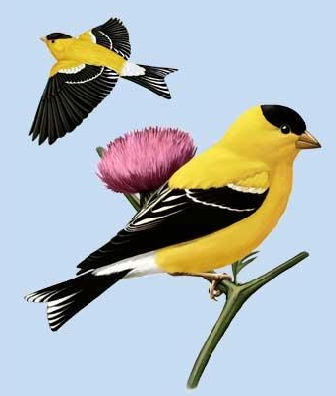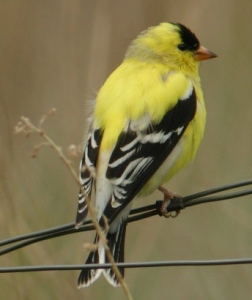
Small, noisy
finch. Male has a bright yellow body, black cap, wings, and tail, and
white rump and undertail coverts. Wings have flashy white patches and
bright yellow shoulder bar. Bill is conical. Undulating flight, alternates
several rapid wing beats with wings pulled to sides. The breeding male
American Goldfinch has a bright yellow body, black cap, wings, and tail,
and a white rump and undertail coverts. The wings have flashy white patches.
Bill is pink and conical.

|
AMERICAN
GOLDFINCH
Carduelis tristis
PASSERIFORMES
Range
and Habitat
American Goldfinch: Breeds from southern British Columbia east to Newfoundland
and south to California, Utah, southern Colorado, central Oklahoma,
Arkansas, and the Carolinas. Spends winters throughout much of U.S.;
prefers brushy thickets, weedy grasslands, and nearby trees.
conical.
SOUND: "per-chick-oree"

The American Goldfinch changes from winter plumage to
breeding plumage by a complete molt of its body feathers.
It is the only member of its family to have this second molt
in the spring; all the other species have just one molt
each year in the fall.
They are one of the latest nesting birds, starting in late June or early
July, when most other songbirds are finishing with breeding. Their late
timing may be related to the availability of suitable nesting materials
and seeds for feeding young.
Brown-headed Cowbirds may lay an egg in a Goldfinch nest, but the hatchling
will usually die because the seed-based diet that the parents provide
cannot support it.
A group of goldfinches has many collective nouns, including a "
007", "charm", "rush", "treasury",
and "vein" of goldfinches.
The American Goldfinch's range is fairly large, reaching up to nearly
8 million kilometers. It can be found in native areas such as Canada,
Bahamas, Mexico and the United States. The population of the American
Goldfinch is currently believed to be quite extensive, around 24 million
individual birds.
 ___ ___

|





